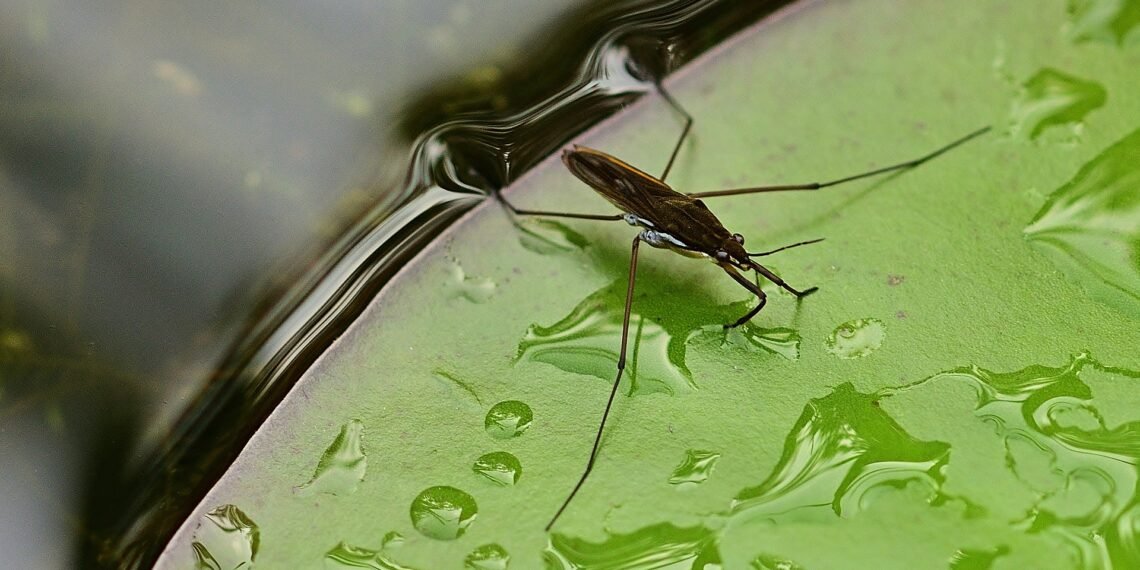Any problem can be easily resolved if we know about the depth of the problem. To find the best solution, study the issue thoroughly. The right approach will surely help you win over the problem. A common difficulty faced by many is waterbug. Most of us are not an expert in water bug identification because many house insects look alike, and that’s why all eight-legged crawling creatures look like house spiders to us. Cockroaches are mistaken as water bugs and vice-versa.
Though both look similar in appearance, biologically, they are completely different. Cockroaches are part of the order Blattodea and waterbugs belong to the order called Hemiptera in the animal kingdom.
Water bugs are usually referred to as oriental cockroaches because they prefer to live in a moist place. They even travel to the higher floors using water pipes and love to live in moist dirty places such as garbage chutes and sewage pipes. Though oriental cockroaches don’t damage the structure, they leave a foul smell.
Types Of Waterbugs?
Water Bugs are common in the US. People get confused with cockroaches due to their size, appearance, and color. These are the species that live either in the water or close to it for humidity purposes and aquatic food sources. Some species are only found indoors, whereas others are near rivers and lakes.
The most common species are:
American Giant Water Bugs

A species found around marshes and streams that use slow-moving streams to look for food. It is probably the largest water bug found in the US, known for its dark brown body. It grows up to 2.4 inches. It is known to bite people. You have to be careful because these water bugs generally fly at night and target artificial light sources.
Water Scorpion
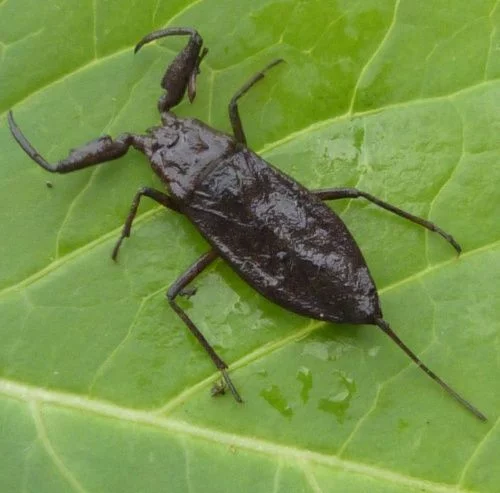
It has been named due to its physical resemblance to the scorpion. It has a large brown body that prefers to stay in still water because these are really bad swimmers. They are mostly found in small ponds with fish and bugs to feed on.
Big-Eyed Toad Bug
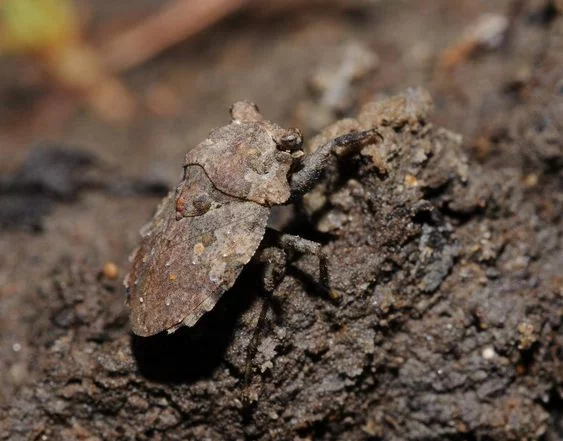
It is a gray species found across North America and Central America. These bugs prefer to stay near sandy beaches, rocky shores, and muddy terrains. They use their color similarities to habitats to hide to defend themselves.
Uhler’s Giant Water Bug

Bug with a large brown body that grows up to 4 inches, mainly found in ponds below the water surface level. They prefer to fly during the night and fly in groups while changing their habitat.
Brown Water Scorpion

Brown water scorpions, also known as walking sticks, have long, thin legs. These bugs have a brown color and live in slow-moving streams. It can hold its breath when submerged in water. They can bite humans and even pierce through the skin.
Eastern Toe-Biter

These bugs are one of the most prominent species of large water bugs that grow up to 2 inches in size and are closely related to Giant water bugs. Their color varies from brown to black; they adapt to their environment and breathe through the abdomen. It can bite humans and pierce through the skin, which can be painful.
Ranatra Linearis

Ranatra Linearis, often confused with Brown Water Scorpion, is hardly visible in the water due to its long and thin body, which appears as an object. These species are found in the Southern US, where people know their biting ability. Their habitat is the meeting point of saltwater and freshwater.
Notonecta Irrorata
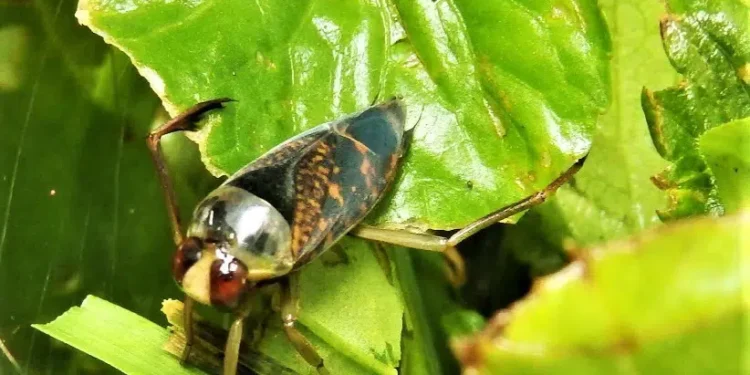
These smaller species grow up to 15mm and can be identified easily by the spots. These bugs are found in lakes and ponds; however, they also move to slow-moving streams if food is readily unavailable.
Lethocerus Medius
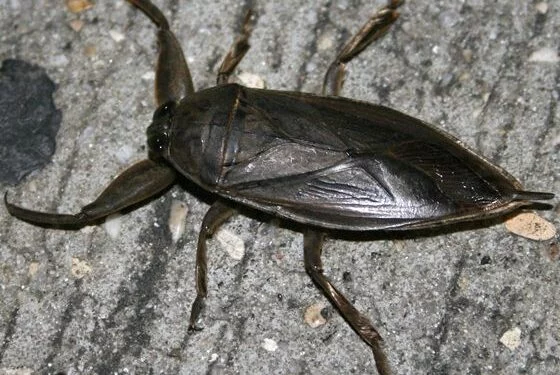
These bugs are found in lakes and ponds using their front legs to grab prey. They live on the surface of the water. Known for its patience in waiting long periods for its prey, it feeds on vertebrates and invertebrates.
Abedus Indentatus
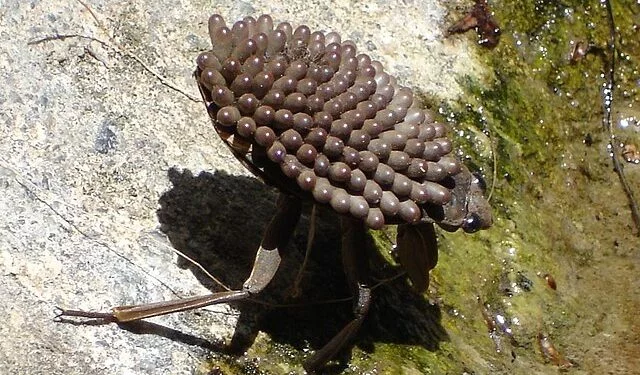
Bugs with a spotted green bodies are found under the surface level in small streams. These species are motionless during the daytime and fly at night. They attach themselves to water bodies to be saved from moving away from the current.
Saucer Bug

These bugs have yellow bodies with brown and black spots which grow up to one inch. They can hold their breath while diving to search for prey.
Greater Water Boatman

These species have derived their name because of their ability to float on the water. They dive only in shallow water so that they can see their prey.
Kirby’s Backswimmer

These species have tricolor bodies and are found in North America. They have mustard-yellow legs and black bodies with red markings.
Laccotrephes Tristis
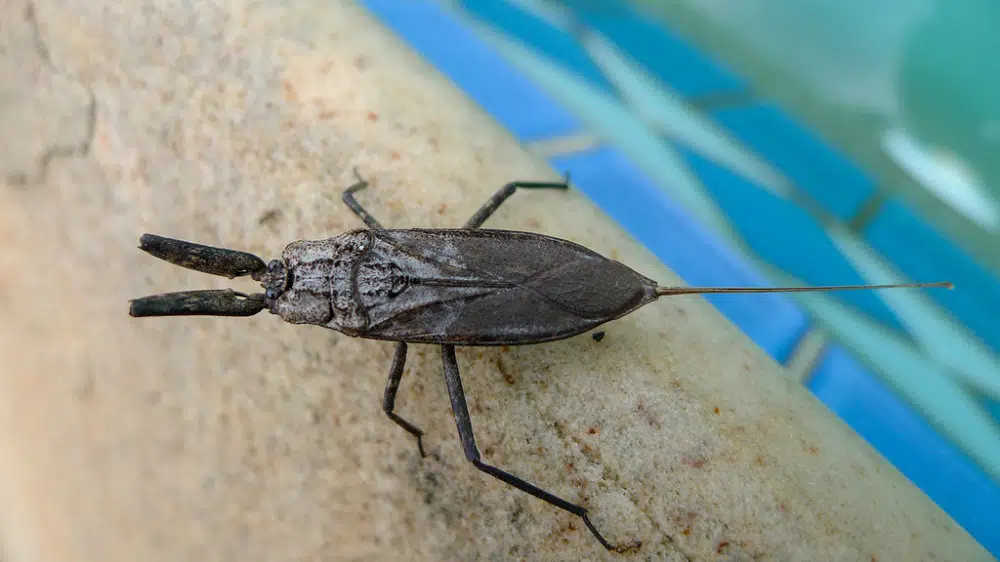
These bugs with brown, flattened bodies are found in the US. Around 60 species of Laccotrephes Tristis are found around the world. They prefer to live in ponds, lakes, and streams and are seen floating in the water.
Asian Giant Water Bug
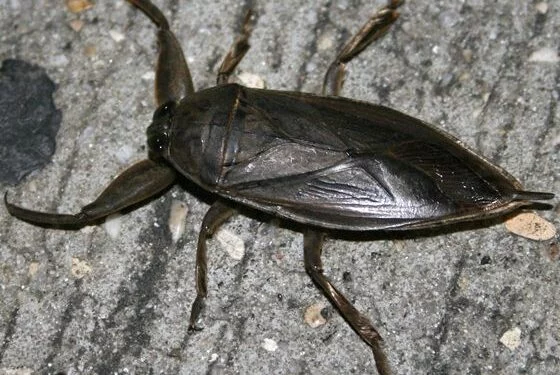
These water bugs are seen in parts of Southeast Asia and have black body with thick legs. Interestingly, these bugs are a delicacy for people in Thailand as part of traditional cuisine.
Pelocoris Femoratus
These species are found in North America, South America, and Central America. These bugs have dark brown body with yellow margins that act as a camouflage. They prefer to move during the night along the slow-moving stream.
Needle Bug
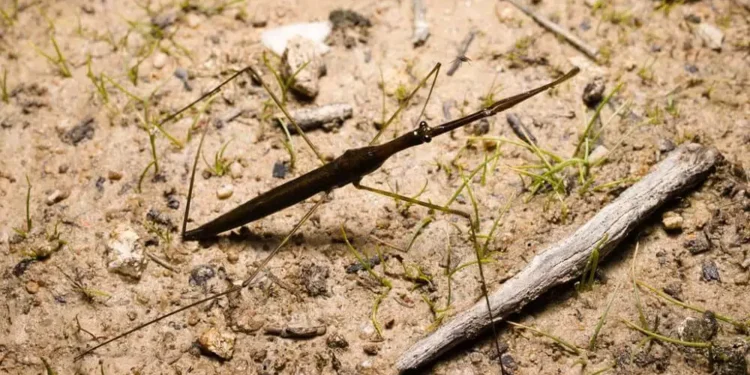
Needle bug has a black body, black legs, and long thin body with extra legs. Due to their body structure, it isn’t easy to detect when they sit motionless on the water’s surface.
How To Identify Water Bugs?
You need to know about the various species to identify them easily. Depending on the species, their appearance differs. However, generally, they have a dark brown or black color appearance. Oriental cockroaches are often confused with water bugs.
What Do Water Bugs Look Like?
It resemble cockroaches with long round body with 3 pairs of legs and antennae. They have flattened bodies similar to cockroaches found inside your house.
How To Differentiate Between Water Bugs Vs. Cockroaches?
Both can be divided based on certain criteria, such as:
- Color – Water bugs are brown or gray, and cockroaches are red.
- Size – Waterbugs are around 2 inches to 4 inches long, whereas cockroaches are about an inch long.
- Antenna -The main difference between the two is that cockroaches have antennae, and water bugs don’t have it.
- Habitat– As the name suggests, water bugs are aquatic and live in water, whereas, cockroaches avoid water.
- Behavior-When water bugs change their habitat, fly in groups and get attracted to bright lights, whereas roaches prefer darkness.
Sources Of Water Bugs In Your House
- Crawling under the doorway
- Entering through the air ducts
- Climbing through the water pipes
- Garbage piles
- Being carried in on food packages
- The bugs stay close to their natural habitat, which means if you see them in your house, their hideout place is nearby.
To know about the tiny bugs in your house, read 12 Common Types Of Tiny Black Bugs In House Near Windows
Food That Water Bugs Eat
They survive on aquatic prey such as tadpoles, small fishes, insects, etc. These bugs often hunt prey bigger than their own size with the help of their front legs.
How To Get Rid Of Water Bugs In Your House?
- The best to deal with waterbug is using a bait trap that comes in 30-millimeter syringe tubes. However, consider following a few steps before launching the destructive mission for them.
- Identify the problem properly through research and ensure it’s a water bug. It will make the problem handling smooth.
- Since you are sure water bugs have entered your house, look around for the entry points. Begin your search around the dark corners you rarely clean; look for gaps in doors, windows, concrete floors and walls, and pipes that connect to the home’s exterior.
- If you cannot locate them, visit the rooms at night where you suspect their presence. Water bugs move during the night, so it’s easy to locate them.
- Now you know their location, so launch the mission. You may use chemicals or some natural materials to trap them. Make sure your application and placement of pesticides are accurate.
- If you are sure of your ability to handle the problem without professional help, go ahead. Else, hire a professional.
What Causes Water Bugs In The House?
Water bugs are aquatic insects found in and around water and never try to enter your house. However, if you leave your porch light on, they may be attracted to your house at night.
Conclusion
Confusion between roaches and water bugs is quite common. Knowing about different species and their harmful effects is essential in dealing with the problems. Seeing waterbugs in home is an unpleasant sight. Identifying the various sources of its entry to your house, taking precautionary measures to stop the entry, and eliminating the existing bugs will help control the situation.
FAQs
Do Water Bugs Go Away On Their Own?
No, they don’t go on their own. You need to eliminate them after identifying the source of their entry points, such as leaking pipes, garbage piles, or wall cracks. You may use chemical or natural materials to get rid of water bugs. Check for sanitation issues, fix any leaks immediately, and trim your plants and shrubs regularly to ensure no bugs get attracted. All these steps will help you deal effectively.
Do Water Bugs Bite?
Not all water bugs bite. A few of the infraorder, Nepomorpha bite, and their bite is harmful. If you see water bugs inside your house, it is most likely that their hideout place is in and around the house. Even if bugs don’t bite, they can cause allergies and diseases.
Any problem can be easily resolved if we know about the depth of the problem. To find the best solution, study the issue thoroughly. The right approach will surely help you win over the problem. A common difficulty faced by many is waterbug. Most of us are not an expert in water bug identification because many house insects look alike, and that’s why all eight-legged crawling creatures look like house spiders to us. Cockroaches are mistaken as water bugs and vice-versa.
Though both look similar in appearance, biologically, they are completely different. Cockroaches are part of the order Blattodea and waterbugs belong to the order called Hemiptera in the animal kingdom.
Water bugs are usually referred to as oriental cockroaches because they prefer to live in a moist place. They even travel to the higher floors using water pipes and love to live in moist dirty places such as garbage chutes and sewage pipes. Though oriental cockroaches don’t damage the structure, they leave a foul smell.
Types Of Waterbugs?
Water Bugs are common in the US. People get confused with cockroaches due to their size, appearance, and color. These are the species that live either in the water or close to it for humidity purposes and aquatic food sources. Some species are only found indoors, whereas others are near rivers and lakes.
The most common species are:
American Giant Water Bugs

A species found around marshes and streams that use slow-moving streams to look for food. It is probably the largest water bug found in the US, known for its dark brown body. It grows up to 2.4 inches. It is known to bite people. You have to be careful because these water bugs generally fly at night and target artificial light sources.
Water Scorpion

It has been named due to its physical resemblance to the scorpion. It has a large brown body that prefers to stay in still water because these are really bad swimmers. They are mostly found in small ponds with fish and bugs to feed on.
Big-Eyed Toad Bug

It is a gray species found across North America and Central America. These bugs prefer to stay near sandy beaches, rocky shores, and muddy terrains. They use their color similarities to habitats to hide to defend themselves.
Uhler’s Giant Water Bug

Bug with a large brown body that grows up to 4 inches, mainly found in ponds below the water surface level. They prefer to fly during the night and fly in groups while changing their habitat.
Brown Water Scorpion

Brown water scorpions, also known as walking sticks, have long, thin legs. These bugs have a brown color and live in slow-moving streams. It can hold its breath when submerged in water. They can bite humans and even pierce through the skin.
Eastern Toe-Biter

These bugs are one of the most prominent species of large water bugs that grow up to 2 inches in size and are closely related to Giant water bugs. Their color varies from brown to black; they adapt to their environment and breathe through the abdomen. It can bite humans and pierce through the skin, which can be painful.
Ranatra Linearis

Ranatra Linearis, often confused with Brown Water Scorpion, is hardly visible in the water due to its long and thin body, which appears as an object. These species are found in the Southern US, where people know their biting ability. Their habitat is the meeting point of saltwater and freshwater.
Notonecta Irrorata

These smaller species grow up to 15mm and can be identified easily by the spots. These bugs are found in lakes and ponds; however, they also move to slow-moving streams if food is readily unavailable.
Lethocerus Medius

These bugs are found in lakes and ponds using their front legs to grab prey. They live on the surface of the water. Known for its patience in waiting long periods for its prey, it feeds on vertebrates and invertebrates.
Abedus Indentatus

Bugs with a spotted green bodies are found under the surface level in small streams. These species are motionless during the daytime and fly at night. They attach themselves to water bodies to be saved from moving away from the current.
Saucer Bug

These bugs have yellow bodies with brown and black spots which grow up to one inch. They can hold their breath while diving to search for prey.
Greater Water Boatman

These species have derived their name because of their ability to float on the water. They dive only in shallow water so that they can see their prey.
Kirby’s Backswimmer

These species have tricolor bodies and are found in North America. They have mustard-yellow legs and black bodies with red markings.
Laccotrephes Tristis

These bugs with brown, flattened bodies are found in the US. Around 60 species of Laccotrephes Tristis are found around the world. They prefer to live in ponds, lakes, and streams and are seen floating in the water.
Asian Giant Water Bug

These water bugs are seen in parts of Southeast Asia and have black body with thick legs. Interestingly, these bugs are a delicacy for people in Thailand as part of traditional cuisine.
Pelocoris Femoratus
These species are found in North America, South America, and Central America. These bugs have dark brown body with yellow margins that act as a camouflage. They prefer to move during the night along the slow-moving stream.
Needle Bug

Needle bug has a black body, black legs, and long thin body with extra legs. Due to their body structure, it isn’t easy to detect when they sit motionless on the water’s surface.
How To Identify Water Bugs?
You need to know about the various species to identify them easily. Depending on the species, their appearance differs. However, generally, they have a dark brown or black color appearance. Oriental cockroaches are often confused with water bugs.
What Do Water Bugs Look Like?
It resemble cockroaches with long round body with 3 pairs of legs and antennae. They have flattened bodies similar to cockroaches found inside your house.
How To Differentiate Between Water Bugs Vs. Cockroaches?
Both can be divided based on certain criteria, such as:
- Color – Water bugs are brown or gray, and cockroaches are red.
- Size – Waterbugs are around 2 inches to 4 inches long, whereas cockroaches are about an inch long.
- Antenna -The main difference between the two is that cockroaches have antennae, and water bugs don’t have it.
- Habitat– As the name suggests, water bugs are aquatic and live in water, whereas, cockroaches avoid water.
- Behavior-When water bugs change their habitat, fly in groups and get attracted to bright lights, whereas roaches prefer darkness.
Sources Of Water Bugs In Your House
- Crawling under the doorway
- Entering through the air ducts
- Climbing through the water pipes
- Garbage piles
- Being carried in on food packages
- The bugs stay close to their natural habitat, which means if you see them in your house, their hideout place is nearby.
To know about the tiny bugs in your house, read 12 Common Types Of Tiny Black Bugs In House Near Windows
Food That Water Bugs Eat
They survive on aquatic prey such as tadpoles, small fishes, insects, etc. These bugs often hunt prey bigger than their own size with the help of their front legs.
How To Get Rid Of Water Bugs In Your House?
- The best to deal with waterbug is using a bait trap that comes in 30-millimeter syringe tubes. However, consider following a few steps before launching the destructive mission for them.
- Identify the problem properly through research and ensure it’s a water bug. It will make the problem handling smooth.
- Since you are sure water bugs have entered your house, look around for the entry points. Begin your search around the dark corners you rarely clean; look for gaps in doors, windows, concrete floors and walls, and pipes that connect to the home’s exterior.
- If you cannot locate them, visit the rooms at night where you suspect their presence. Water bugs move during the night, so it’s easy to locate them.
- Now you know their location, so launch the mission. You may use chemicals or some natural materials to trap them. Make sure your application and placement of pesticides are accurate.
- If you are sure of your ability to handle the problem without professional help, go ahead. Else, hire a professional.
What Causes Water Bugs In The House?
Water bugs are aquatic insects found in and around water and never try to enter your house. However, if you leave your porch light on, they may be attracted to your house at night.
Conclusion
Confusion between roaches and water bugs is quite common. Knowing about different species and their harmful effects is essential in dealing with the problems. Seeing waterbugs in home is an unpleasant sight. Identifying the various sources of its entry to your house, taking precautionary measures to stop the entry, and eliminating the existing bugs will help control the situation.
FAQs
Do Water Bugs Go Away On Their Own?
No, they don’t go on their own. You need to eliminate them after identifying the source of their entry points, such as leaking pipes, garbage piles, or wall cracks. You may use chemical or natural materials to get rid of water bugs. Check for sanitation issues, fix any leaks immediately, and trim your plants and shrubs regularly to ensure no bugs get attracted. All these steps will help you deal effectively.
Do Water Bugs Bite?
Not all water bugs bite. A few of the infraorder, Nepomorpha bite, and their bite is harmful. If you see water bugs inside your house, it is most likely that their hideout place is in and around the house. Even if bugs don’t bite, they can cause allergies and diseases.

